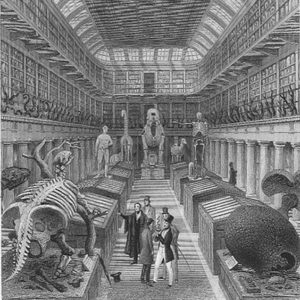– New research guide to the Library’s Museum Studies and Heritage collections –
 With research in the fields of museum studies and heritage continuing to expand and develop as a key trend in history, the IHR library has recently compiled a guide to the library’s museum studies and heritage collections. The guide provides an overview of the library’s holdings, gives details of the range of sources available for consultation, and highlights two case studies – the British Museum and the Imperial War Museum respectively. Relevant sources for the study of both institutions are outlined within the collection guide alongside relevant holdings within the library’s electronic resources, journals and periodicals. Throughout, the collection guide documents relevant examples on the architectural history, patronage, social history and visitor statistics for a range of institutions. These examples are designed to highlight the range of sources available in the library for researchers studying museums and heritage practices.
With research in the fields of museum studies and heritage continuing to expand and develop as a key trend in history, the IHR library has recently compiled a guide to the library’s museum studies and heritage collections. The guide provides an overview of the library’s holdings, gives details of the range of sources available for consultation, and highlights two case studies – the British Museum and the Imperial War Museum respectively. Relevant sources for the study of both institutions are outlined within the collection guide alongside relevant holdings within the library’s electronic resources, journals and periodicals. Throughout, the collection guide documents relevant examples on the architectural history, patronage, social history and visitor statistics for a range of institutions. These examples are designed to highlight the range of sources available in the library for researchers studying museums and heritage practices.
While researching the collection guide, one example from The Times, 25 January 1884 entitled ‘The Museum in New York’ proved particularly striking for its account of a law suit involving the then Director of the Metropolitan Museum of Art. The article notes of the museum that, ‘the Museum of Art is not a public institution. It is a strictly private corporation. It is the child of a number of enthusiastic gentlemen, who in November, 1869, held a meeting in this city for the purpose of creating some institution that would emulate the British Museum.’ In addition to providing commentary on the museum’s establishment, the article also details an alarming disregard for conservation practices. The correspondent states that during the trial it was offered ‘to let the plaintiff hack several statues to pieces in open court to test their genuineness; and a sculptor actually did hew off fragments from one of the images, in presence of Judge and jury, to show that the ancient relic was actually made of solid stone and not of cement.’
 Commentaries on a range of museums can also be found in the library’s collections of personal testimonies, diaries and correspondence. For example, Krystyn Lach-Szyrma, a Polish philosopher who travelled across Britain between 1820 and 1824, described the Hunterian Museum in Glasgow as, ‘a rich collection of animals, plants, minerals, medals and manuscripts left by the famous doctor Hunter who studied at this University. The Anatomical Hall is the most interesting of all. I have seen there all the parts of the human body preserved in alcohol…The seats of feeling and of thought are thus the places where life begins!’
Commentaries on a range of museums can also be found in the library’s collections of personal testimonies, diaries and correspondence. For example, Krystyn Lach-Szyrma, a Polish philosopher who travelled across Britain between 1820 and 1824, described the Hunterian Museum in Glasgow as, ‘a rich collection of animals, plants, minerals, medals and manuscripts left by the famous doctor Hunter who studied at this University. The Anatomical Hall is the most interesting of all. I have seen there all the parts of the human body preserved in alcohol…The seats of feeling and of thought are thus the places where life begins!’
The library’s collections in museum and heritage studies are continuing to grow. One of the latest titles to arrive in the library, Interpreting Native American History and Culture at Museums and Historic Sites, features best practice case studies for museum professionals involved in caring for collections of Native American material culture. Of particular relevance for museum studies researchers is the chapter entitled ‘Taking Responsibility for Museum History and Legacy: promoting change in collections management’. This chapter provides insightful discussion into ethical considerations for collection management as well as providing a historical background to collecting practices in museums across the United States.
The Museum Studies and Heritage collection guide complements the library’s guides to History of Art and Design and Memory and Commemoration. Alongside these resources, the guide also provides information of other relevant libraries and institutions with extensive resources on the study of museums and heritage. If you have any comments or suggestions regarding our collection guides, please contact us.
